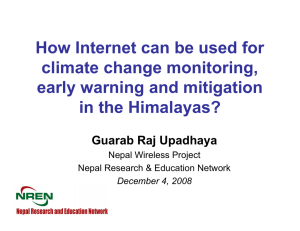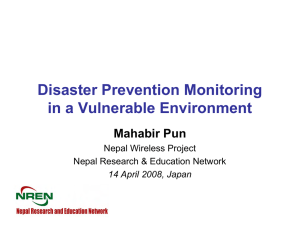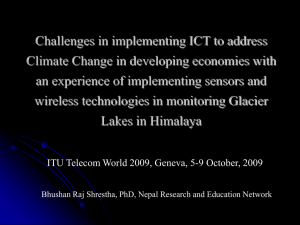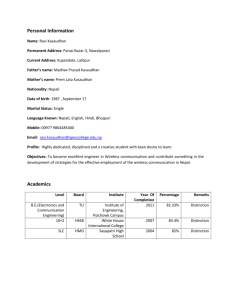Disaster Prevention Monitoring in a Vulnerable Environment Mahabir Pun Nepal Wireless Networking Project
advertisement
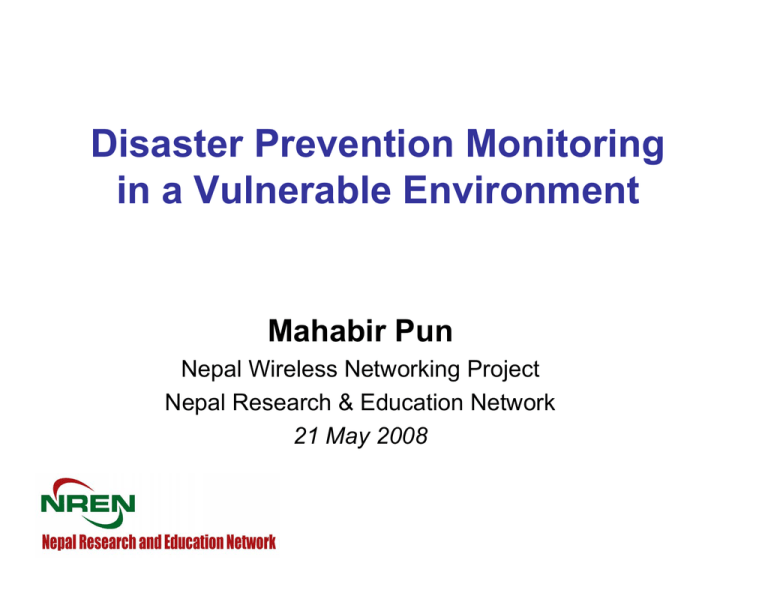
Disaster Prevention Monitoring in a Vulnerable Environment Mahabir Pun Nepal Wireless Networking Project Nepal Research & Education Network 21 May 2008 My Involvement • Chairman, the Institute for Himalayan Conservation – Nepal since 2000 • Team Leader – Nepal Wireless Networking Project since 2002 • Vice Chairman – Nepal Research and Education Network since 2006 Relay Station 1 Receiver at 3,220m My Role as an Activist in ICT Field • Led the successful campaign to de-license 2.4 GHz and 5.8 Ghz Industrial, Scientific and Medical (ISM) bands in 2006 in Nepal. • Lobbied successfully to reduce the license fee to approx. $3 per year for those small businesses that are interested to set up ISPs using VSAT in rural Nepal • Led the team successfully to make Government owned Nepal Telecom share its copper infrastructure with private Internet Service Providers for providing ADSL services to the customers in 2008. • Working on to build Broadband Information Highway using Wireless technology across Nepal. Nepal Context • 8 out of 10 highest Mountains in the world and many peaks over 7,000 m. • Total Glaciers - 3252 covering 5223 sq. km in Nepal • 2323 glacial lakes in Nepal ( Source: ICIMOD and UNEP) Glaciers and glacial lakes in Nepal Mahakali Basin Karnali Basin Gandaki Basin Koshi Basin Glacial lakes - 2323 Potentially dangerous glacial lakes Source: Hiromichi FUKUI, Faculty of Policy Management, Global Security Research Center, Keio University Impact of Global Warming in the Himalayas • Rate of increase of warming by 0.15 °C to 0.6 °C per decade • Rate of glaciers shrinking is higher in recent decades • The numbers of Glacial lakes are increasing • Glacial lakes Outburst Floods (GLOFs) has been happening in the Himalayas GLACIAL LAKE OUTBRUST FLOOD • The highest risk from climate change is the increasing risk of Glacial Lake Outburst Flood – Impacts upon mountain eco-system – Displaces downstream villages – Further south, huge damage to corps and other livelihoods • There are many new glacial lakes being formed in the high Himalayas – 20 potential GLOF in Nepal GLOF Risks in the Himalayas • Extensive Study only done in Dudhkoshi Basin by Samjwal et al (ICIMOD) – Big Damage due to Dig Tso burst in 1985 – Preventive work has been done in Tso Rolpa glacial lake by building mitigation system. – Current Research work between NREN, ICIMOD, DNPW, Keio University, NARO and APAN-JP on Imja Lake in the Everest region. Imja Lake Monitoring Project Started by Keio University Japan, in collaboration with Sagarmatha National Park (SNM), Nepal and International Center for Integrated Mountain Development (ICIMOD) and Nepal Research and Education Network, Nepal (NREN) Imja Glacier Retreat and Growing Lake Source: Hiromichi FUKUI, Faculty of Policy Management, Global Security Research Center, Keio University •CORONA •SPACE SHUTTLE 15 DEC 1962 DEC 1983 •ENVISAT, ASAR, 18 October 2007 •LANDSAT TM 1992 •Quickbird Jan 2006 •IRS ID PAN 19 MAR 2001 •IRS LISS3 2005 Objectives • To demonstrate the real time monitoring of Imja glacial lake as a pilot study for potential Glacial Lake Outburst Flood hazard • To provide early warning to save mountain communities, infrastructure and environment • To build local area Wireless network (wifi) between the villages and connect with VSAT terminal to provide Internet connectivity and access for the local community Networking of field sensor and transmission station in Mt. Everest region for the real time monitoring of Lake Imja Tsho • Everest • Everest base camp • Kalapathar • Khumbu Glacier • Loboche (Pyramid) • Chhukung Ri • Imja lake 25 Km • Phortse • Dingboche • Tengboche • Namche bazaar • Quangde • Pangboche Imja Lake at 5,110 m Wireless Relay at Chhukung with Prof. Hiramichi Fukui Picture of field server deployment Real Time Image of Imja Lake (2008/5/19, 09 AM) Real Time Image of Imja Lake (2008/5/19, 09 AM) Regular Monitoring, Early Warning and Mitigation Measures • • • • Simulation of GLOF Vulnerability and risk assessment (Near) Real time monitoring Networking of field sensor and transmission station • Wireless Sensor Network Lessons Learned • ICT technologies can help in monitoring and documenting changes. • Will also help in taking preventive measures. • ICT can also increase the awareness in local communities about potential hazards • A public private partnership between local communities, government, service providers and scientific researchers can only get the work done Lessons Learned • Wireless Network can be made to work in remotest areas • Low power self sufficient devices embedded with appropriate sensors are needed to avoid big impact on fragile ecosystem • Power storing technology still needs more work for remote and cold areas. Current and Next Steps • Enhanced observation, monitoring • Promote exchange of data and information • Enhance cooperative studies among other area • Promote capacity building • Considering systematic way for mitigation and adaptation Our Bigger Plan • Deploy more wireless enabled field stations – Weather stations, sensor network, field servers • Build a wireless network from Mount Everest region to Dhaulagiri /Annapurna region to monitor climate changes by putting field servers between the six 8000m+ and several 7000m+ mountains in the Himalayan region. Mount Everest to Dhaulagiri ~ 370 KM Invitation to all Interested Parties • Nepal Research and Education Network, Nepal Wireless Project and partners in Nepal welcome other participants from around the world who have stakes in these activities. • Imja Field Server website to get real time data and video pictures: – http://fsds.dc.affrc.go.jp/data4/Himalayan/ Thank you • Contact: mahabir@himanchal.org • http//www.nepalwireless.net • http://www.nren.net.np Please look at the real time data from the field servers in Imja Lake near the Mount Everest and Namche Bazar, Nepal by clicking at the link below. http://fsds.dc.affrc.go.jp/data4/Himalayan/
